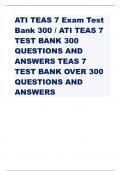Summary
Summary Microeconomics I Economics and Business Economics VU University, ISBN: 9781319153960 Microeconomics I (E_EBE1_MICEC)
- Course
- Institution
- Book
Comprehensive summary of Microeconomics I, a first year course of Economics and Business Economics at the VU.
[Show more]













